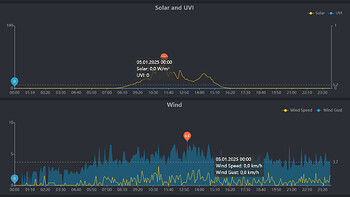Hi there, I want to share my perhaps noob confusion, but I have no idea where to find the answer. I’ve had my ecowitt WS80 for a few months now and in both the mobile app and the web app there are dashed lines in the sensor graphs, always with a value.
I thought these were averages over the displayed period, but what is weird is that when I look at a week, it says for wind for example 6.4 kph on the dashed line, but if I look at the individual days, it says 6.7, 8.4, 7.7, 2.5, 2.4, 3.2, 3.1 kph respectively. The average from that gives 4.85. The median from such small set is of course 3.2, which wouldn’t be a very helpful value.
So I wonder if it’s a median value from all the values recorded? But it seems a bit silly - if I look at weeks in a month and it says 6.4, 12.3, 14.4, and 6.6 and then look at the month and it says 13.3, it seems a bit suspect.
The weirdest is then the yearly level (which is incomplete in my case), but over four months it was 15.2, 12.1, 13 and 13.3, but somehow, for the year 2024 the value displayed is 20.2 kph! That’s bonkers and we surely have not had 20.2 kph average OR median wind gusts of 20 kph.
The situation is pretty much the same with solar irradiation. At first I thought I could use the “average” value to calculate the amount of energy available for a potential solar panel instalation, but the values don’t seem representative. If I used the dashed-line-value of W/m2 and multiplied it with the number of hours in a year, I come up with a totally crazy number of Wh.
Does anyone have any ideas?




